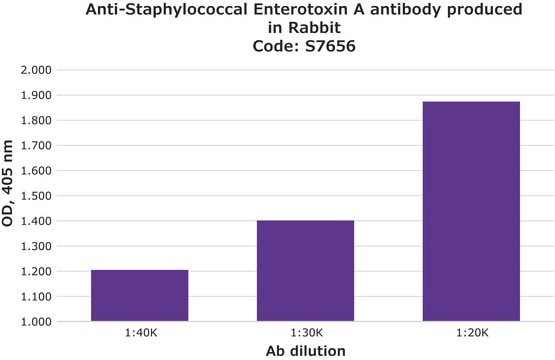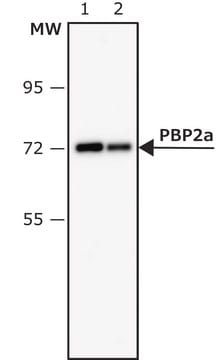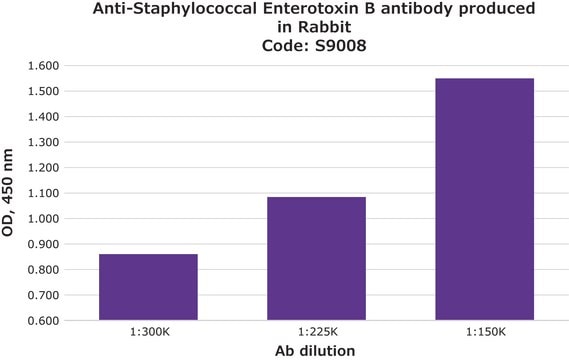General description
Staphylococcus aureus is a Gram-positive bacterium, that causes disease in the human population including food poisoning and toxic shock syndrome.1 S. aureus expresses several secreted virulence factors, such as various enzymes, cytotoxins, exotoxins, and exfoliative toxins.1 Exotoxins include more than 20 serologically classified staphylococcal enterotoxins (SEs)
Specificity
Monoclonal Anti-Staphylococcal Enterotoxin B antibody specifically recognizes staphylococcal enterotoxin B (SEB) and has no cross reactivity with staphylococcal enterotoxin A (SEA), cholera toxin, or pseudomonas exotoxin A.
Application
The antibody may be used in various immunochemical techniques including Immunoblotting and ELISA. Detection of the staphylococcal enterotoxin B bands by Immunoblotting is specifically inhibited by the immunogen.
Biochem/physiol Actions
Exotoxins include more than 20 serologically classified staphylococcal enterotoxins (SEs). The best characterized are the SEs A, B through V, and toxic shock syndrome toxin-1 (TSST-1). These enterotoxins are similar in activity, sequence, structure, and molecular mass (25-30 kDa).1-3 SEA and SEB are known as superantigens due to their ability to bind class II MHC molecules on antigen presenting cells. This binding stimulates extensive T-cell activation followed by massive cytokine release leading to an acute toxic shock.1-4 SEB is also classified as a category B select agent and is important toxicant in biodefense research.5-9SE proteins have a significant resistance to heat and acid, and are also resistant to gastrointestinal proteases including pepsin, trypsin, rennin, and papain. Thus, inactivating the S. aureus bacteria may not be sufficient to eliminate the risk of its superantigens from causing food poisoning.1SEB contamination can be caused by both its ingestion (resulting with food poisoning) or by inhalation (resulting with respiratory symptoms of cough and dyspnea), therefore SEB detection is a major challenge in the food industry.1,3,5-10
Physical form
Supplied as a solution in 0.01 M phosphate buffered saline pH 7.4, containing 15 mM sodium azide as a preservative.
Storage and Stability
For continuous use, store at 2-8°C for up to one month. For extended storage, freeze in working aliquots. Repeated freezing and thawing is not recommended. If slight turbidity occurs upon prolonged storage, clarify the solution by centrifugation before use. Working dilution samples should be discarded if not used within 12 hours.
Disclaimer
Unless otherwise stated in our catalog our products are intended for research use only and are not to be used for any other purpose, which includes but is not limited to, unauthorized commercial uses, in vitro diagnostic uses, ex vivo or in vivo therapeutic uses or any type of consumption or application to humans or animals.









